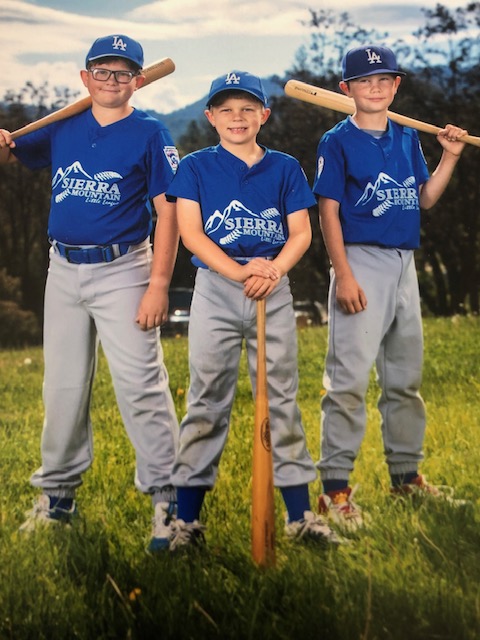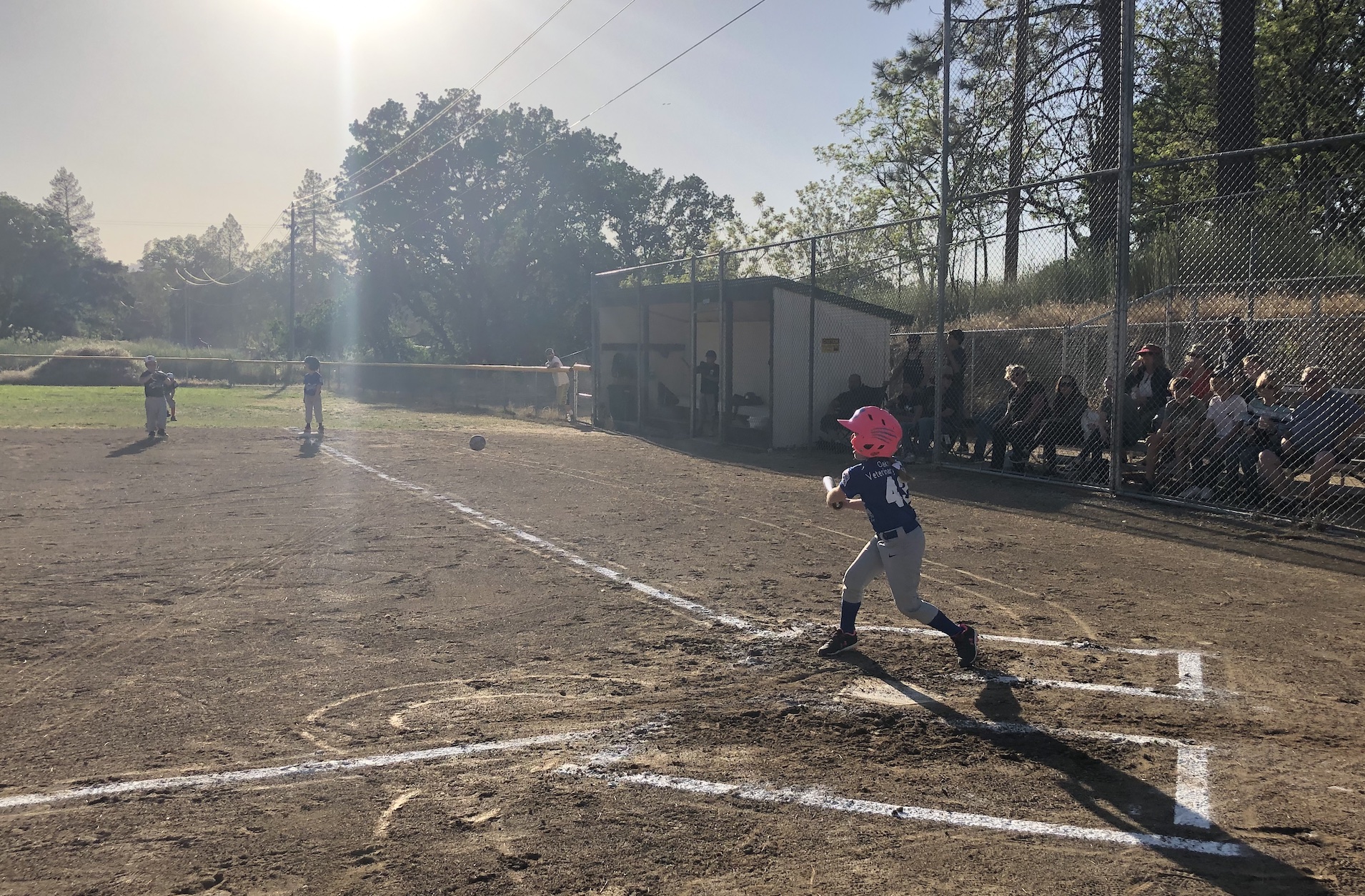Parents
Welcome, parents! Please see the information below, where we’ve tried to answer many common questions.
Who can play?

Boys and girls ages 4-13 can play baseball with the Sierra Mountain Little League. Girls ages 9-12 can play softball here.
You can find out your player’s age for division placement at the Little League Age Finder. Note that the formulas for baseball and softball league ages are different: a baseball player’s is how old they are on Aug 31, a softball player’s is how old they were at the end of the year prior.

Sign Up
SMLL’s primary season is in the spring. We open registration from December through February and expect to start our practices immediately after the Bass Lake School District’s spring break. Our game season is typically from late March through early June, with playoffs and All Stars continuing for a few weeks afterward.
If you’d like to sign up your kids:
-
Register players at Sports Connect.
-
Players in AAA and above will need to attend a player assessment sometime in February.
-
Your players will be assigned to teams between assessments and the start of the season. The registration system will send out email notifications once players have been assigned. Coaches will reach out in this period to announce practices.
-
The first games are generally 2 weeks after practices begin, sometime in the 2nd half of March.
-
The last games of the season will usually be at the end of May or the beginning of June.
See the News section for specific dates.
How do I know my kid’s league age?
Please see the League Age & Divisions post for an overview of how player ages work with our game divisions.
Volunteer
Sierra Mountain Little League is run entirely by volunteers – working parents just like you who want to invest in their kids and their community. The whole system takes a lot of time and effort and many hands working together to make it happen. After you register your players in Sports Connect, you’re given a chance to sign up for various ways we need help. Please consider registering your interest through one of the available options there, or reach out to your coach as soon as teams are assigned.
Volunteer opportunities include:
- Being a team manager or coach
- Helping your coach with practices and games
- Keeping score during games
- Serving in the snack bar during games
- Being a team parent, helping with organization and communicating with the other parents
- Helping prep fields before games – raking, chalking, putting out bases, sweeping the dugouts, putting the pitching mound on the Minors field, cleaning up the seating areas, returning the trash cans to their space by the snack bar.
Please see our Roles page for more info.
Player Safety
SMLL places a lot of value on player safety. If your child has any special health conditions, like the need for an EpiPen or an inhaler, please talk to your coaches about it. Make sure they know how to recognize signs of problems and how to deal with them. They’ll want to be prepared in case there’s an emergency, and they should be able to recognize changes in your childrens’ normal behavior.
Note that every season, one coach on every team must get training for first aid and basic baseball fundamentals.
All clothing and equipment should be in good repair. Bats may not be damaged. Boys need to wear an athletic supporter. Male catchers must wear a cup. Aside from some exceptions, jewelry is not allowed (see below).
Player safety also includes vetting our volunteers with in-depth background checks and training them to recognize abuse. Please see our Background Checks & Training page for more information.
Little League also encourages parents to take advantage of USA Baseball’s Abuse Awareness for Minors program as well.
Concussion Awareness
All parents of SMLL’s players should read this concussion information sheet from the CDC, sign it at the beginning of each season, and return it to their coach.
For more, please see the CDC’s HEADS UP to Youth Sports for parents.
Sudden Cardiac Arrest
All parents of SMLL’s players should read this sudden cardiac arrest information sheet, sign it at the beginning of each season, and return it to their coach.
For more, please see the Eric Paredes Save A Life Foundation’s Free SCA Prevention Training.
Wearing Jewelry
Little League Rule 1.11(j) states:
Players must not wear jewelry such as, but not limited to, rings, watches, earrings, bracelets, necklaces, nor any hard cosmetic/decorative items. This rule applies regardless of the composition of such jewelry, hard cosmetic item, or hard decorative item. Hard items to control the hair, such as beads, are permitted.
EXCEPTION: Jewelry that alerts medical personnel to a specific condition is permissible.
See this Little League summary and the Little League® Significant Rule and Regulation Updates for 2023 section covering 1.11(j) for more.
Equipment
What do your kids need to play baseball or softball with SMLL?
- ball glove
- cleats
- uniform pants
- uniform belt
- uniform socks
- athletic supporter or compression shorts (required for all boys in all divisions; catchers must wear a cup)
- batting helmet (encouraged to purchase your own)
- bat (optional but recommended)
- batting gloves (optional but recommended)
See Get the Gear and What to Wear for Little League® Practices for more tips on what’s needed and useful.
What does the league provide?1
- game-day jersey
- baseball cap
- catcher’s gear for the team
- batting helmets as needed
- bats as needed
See What Parents, Local Leagues Need to Know About Equipping a Little Leaguer®
Bringing your own bat and helmet is optional. The league or coach can provide both, and many players are happy to share their bats. Don’t be afraid to ask your coach or someone else in the league for hand-me down gear, too. Kids are always growing out of their equipment and parents are often pleased to have the opportunity to pass it on.
See the Little League Rulebook’s Appendix B - Safety Code for Little League for the exact rules.
What can’t your kids wear? See Player Safety above.
More guidance for how we approach equipment at SMLL is given below.
Bats
Little League offers a Bat Information page that collects their rules and guidelines.
Curious what umpires are looking for when they do a bat inspection before every game? See Playing Equipment Inspection: Baseball and Softball Bats
Bats must be in good repair and not be altered (see LL Rulebook Appendix D).
Please note that bat warm-up donuts are not allowed.
Pine tar and other adhesives are strictly prohibited.
Baseball
| Division | Standard | Dimensions | Notes |
|---|---|---|---|
| Tee Ball | USA Bat | Length <= 26” | Only for use with approved Tee Balls |
| AAA, Minors, Majors | USA Bat | Length <= 33” Diameter <= 2 5/8” |
For wood, USA Bat not required |
| Intermediate (50-70) | USA Bat, BBCOR | Length <= 34” Diameter <= 2 5/8” |
For wood, USA Bat not required |
For all baseball players from Tee Ball to Majors, non-wood bats must be certified by USA Baseball and marked with the USA Bat standard (they will say “USA Baseball”). For 50-70, non-wood bats may also be certified by BBCOR.
Aluminum, composite, hybrid, and wood bats are allowed. See baseball rule 1.10 for details.
Softball
| Division | Standard | Dimensions | Notes |
|---|---|---|---|
| Tee Ball, Minors, Majors | None | Length <= 33” Diameter <= 2 1/4” |
Non-wood – BPF 1.20 |
| Juniors, Seniors | None | Length <= 34” Diameter <= 2 1/4” |
Non-wood – BPF 1.20 |
For all divisions, a softball bat must meet those limits. It may be wood or another common bat material. It may be colored. It must have a grip if it’s not wood.
See softball rule 1.10 for details.
Softballs
If you want to buy your player a softball to practice with at home, make sure you get one of the right dimensions. These are the sizes we’ll use in each division:
| Division | Diameter | Weight |
|---|---|---|
| Tee Ball, Minors | 11” | 5½-6 oz |
| Majors+ | 12” | 6¼-7 oz |
Note that optic yellow, white, or other colors are all permitted.
Little League endorses some balls, but any ball of the right dimensions should be fine. Please see Rule 1.09 of the official Little League Softball rules for specific ball regulations.
Hats
Baseball players must wear their cap during a game. It’s an important part of their uniform toolkit for maintaining good vision and protecting their eyes and face from the sunlight.
Softball players may wear a cap or visor, but it’s not a requirement. Nevertheless, it is still a valuable shield against strong light and UV.
Shoes
“Can you use cleats from another sport?” Yes! Cleats with plastic or rubber studs can be used up through Majors. In 50-70, Junior, and Senior leagues, metal-spiked cleats may also be used.
“Can you use shoes that aren’t cleats?” Yes. Cleats are not required, but they are wise. A player should always wear shoes that will give them good traction in dirt and grass, fit snugly, and stay on during running and sliding. Laces should be in good repair and the shoes should be able to stay laced a reasonable amount of time. Don’t get your coach in trouble because your player’s shoes come untied during a game! Your team could be penalized because a player wasn’t ready or safe and delayed the game.
Pitcher Arm Coverings
Pitchers may wear an undershirt, but the sleeves must not be white or gray if they’re visible.
Pitchers may wear a play-calling band on their glove arm. It must be a solid color and not white, gray, or optic yellow.
Pitchers may not wear sweat bands on their hands, wrists, or arms.
Pictures
Near the end of every season, the league has a picture day. Team and individual photos are included as part of registration, and the photographer typically offers additional packages that players and their families may purchase.
Rule Highlights
Little League has highlighted a number of things that are often misunderstood. Please see Common Little League® Rule Misconceptions: What Parents Need to Know and 10 Commonly Misinterpreted Little League® Rules.
Further Reading
We have various resources available on our site.
-
See Little League’s What Equipment does our league need to provide for regular season? ↩